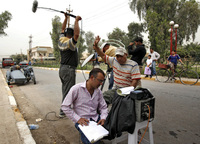Priorities
As mentioned before, Production Sound is an art of compromise on the set. Dialogue is recorded with Picture, and both must give way a little bit.
The job of the Production Mixer is to record raw material for the editors and re-recording mixers to transform into a finished soundtrack.
Therefore, the first priority is to get the Dialogue any way possible that would be usable. In the event that laying down usable dialogue is impossible, then one should still try to get as near perfect a track anyway, even if it is only to be used as a guide track for ADR (looping).
Second priority would be to record the Dialogue in matching perspective for the camera angle. What the audience sees is essentially what they should hear. For example, a person walking away from the camera should not get louder (just because the actor is moving closer to a hidden mic in the back of the set). A close-up should not be louder than the medium shot, since all that has changed on-screen is the camera angle, not the distance from audience to actor.
The final priority is to record Sound Effects to accompany the shot. This might include such things as footsteps, hand props, doors, etc. Sometimes this is recorded during the actual take, during a rehearsal, or after the shot. Some productions may also ask for Presence (room tone).
Hint: If you are requested to record Presence, arrange to do it just before the camera roll of the first take. That way, everyone is in position and the sound will be an exact match of the actual take. Waiting until the end of the last take results in having to fight the commotion of exiting talent, crew, and wrapped equipment. Room tone recorded in an empty set is hollow and would not easily intercut with the actual take. Room tone is intended as emergency filler that the editor can splice into a live scene in order to replace unwanted noise. It should be an exact match for the dialogue scene: same mic, same angle; same volume setting -- just no dialogue.
Recording sync sound effects can be the most trying from a political standpoint. Editors like sound effects, but on isolated tracks. Producers, on the other hand, are impressed by sync sound effects on the main track during the screening of dailies. Production Managers hate anything that slows up the pace of things on the set, even if it would save money later.
It is essential to determine how the show is going to be handled from an editorial standpoint. For instance, somet non-theatrical video productions may not have a budget for extensive audio sweetening, other than to lay in some music, narration, and a few key sound effects. In that situation, a good mixer might try to pack the track with as much texture and live sound effects as necessary, without endangering either the clarity of the dialogue or the ability to intercut shots. On the other hand, a feature film editor would prefer a "clean" soundtrack that can be embellished on the cutting bench.
The Hierarchy of Microphone Techniques
 There are four basic ways to approach miking a subject: boom; plant; lavaliere; or radio mic.
There are four basic ways to approach miking a subject: boom; plant; lavaliere; or radio mic.
In most instances, the best dialogue will be achieved by employing a boompole overhead of the subject. A good condenser shotgun mic, angled a couple of feet and slightly ahead of the subject will produce a crisp, natural tone. The sound will not be affected by clothing noise or bodily movement (such as arms folded across the chest). Talent can move around, walk, sit, etc. -- with the mic following overhead. Multiple performers can interact with each other, both verbally and physically, without rustle or phasing problems.
In a pinch, the boompole can be held at knee level with the mic pointing up. There may be a resulting slight increase of bass, but that is easily corrected on the mix panel or later on in post.
There is no difference (to the mic) between a boompole that is not moving and a C-clamp. Fixed microphones, also known as plant mics, can be strategically deployed around the set to cover isolated characters that would be impractical to reach with the boom.
Plant mics can consist of either regular condensers or suitable lavalieres. The new mini-lavalieres, with their great sensitivity and transparency, make excellent plants. They are so tiny that they can be hidden right in the middle of the scene and not show up on camera.
Plants can be hidden in doorways, on executive pen sets, on the edge of dressing mirrors, bed headboards, automobile sun visors, even in floral arrangements!
Employ shockmounts to avoid noise and vibrations from being directly conducted to the mic. On lavalieres, a small loop of tape works nicely.
Pay strict attention, though, to multiple mic phasing. A plant and a boom overlapping can easily result in mush, unless you keep your hands busy on the pots.
Lavalieres are the next option. Worn on the body, they tend to go (or stay) where the actor is. As mentioned earlier, the proximity oriented mics (e.g. Sony ECM-55 & ECM-44) tend to add presence to the dialogue as well as to reject background noise. Transparent sounding lavs (e.g. Sony ECM-77b, Audio Technica AT899, Sennheiser MKE-2) blend better with overhead condensers and sound more natural or less "forced." On the other hand, they do not screen out background ambiance as much.
If the actor is going to be walking, and a cable dragging from his or her ankle is impractical, then radio mics are the final resort.
